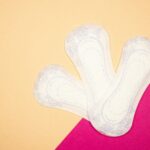Intro and interview by Amanda Flinn
Ashlyn Kinman loves being able to express herself through art. Growing up in Memphis, Tennessee, she remembers making friendship bracelets and working her way through rainy-day activity books. In elementary school, she had an art teacher whose love of creative activities poured over into her. And when she visited her grandmothers who were both artistic, they let her get into and explore their craft supplies.
Art allows Kinman to see the world in a different way. As a high school student, Kinman joined the yearbook staff and navigated her way through photography and graphic design. Upon graduation, her love of art led her to Southeast Missouri State University (SEMO), where she explored sculpture and created a body of work about women’s reproductive health before graduating in 2021.
Here, Kinman shares the inspiration behind this work and the importance of talking about it.
Amanda Flinn: Can you tell us about your decision to attend SEMO and pursue art?
Ashlyn Kinman: Choosing art as a major wasn’t an easy decision — you have a lot of people trying to navigate you away. For the longest time, I wanted to be a veterinarian. But being in yearbook throughout high school, something just clicked. I have always enjoyed computers and technology, so combining those with graphic design and being able to incorporate photography — an art degree checked all the boxes. As for moving to Cape and going to SEMO, I had some connections to people in the area. Once I visited, I fell in love with the people and the town.
How did you decide to create a body of work about women’s reproductive health?
This was a personal project for me. As a woman, I had been thinking about subconscious thought and the issues we go through [related to reproductive health] — what’s normal and what’s not. My graphic design professor spoke freely about her experiences [regarding feminism, art and women’s health], and I was starting to gain confidence about touching on these issues, too. I wanted to create something people could discuss as a tribute to the women around me.
What was your process in creating it?
I wanted to work with yarn and fiber materials. My maternal grandmother worked a lot with fiber mediums — sewing, knitting, crocheting — and in sculpture, I had been learning to stay in a state of play, being free, not too focused on trying to make something happen. Using leftover materials, I found plaster pieces already cast from their molds. Then, using yarn, ceiling tile, mixed media, print and photography, I played around with different ideas. “Crimson Wave” was the first piece that brought it all together.
How long did it take you to create this installation?
It didn’t take long to assemble — probably a month and a half to two months working in the studio — but the thought process happened over several years. I knew I wanted to make art about [my experiences as a woman], but wasn’t sure how to bring it all together. For this project, it was the right place and the right time.
How did you choose the name of each piece?
The names are all euphemisms for period terms. I really like playing with words. “Code Red” is an interactive piece, like a monthly calendar. I could go in and move the yarn to represent different days of the period cycle while it was on display. “Crimson Wave” represents the physical parts. “Lady Business” has three parts. The first is the mental effects our hormones have on us and the different ways we feel throughout the month. The second piece symbolizes the bind of not wanting to get out of bed or the physical pain. It can be unbearable sometimes. The third is a gift. I used the same plaster piece from “Crimson Wave,” but here, it’s tied up in a bow.
Why is talking about women’s health an important topic for you?
I think we’ve made a lot of progress in the tabooness of [talking about] it, but we need more open spaces for conversation and acceptance. As a twin and older sister of two more siblings, I want young women to advocate for themselves when it comes to medical things and to ask questions when something doesn’t feel right. As women, we can all identify with and share in the struggle.
What have you been up to since graduation? And what’s next for you?
I’m back in Memphis and working full-time in graphic design, but I try to get to Cape Girardeau at least a few times a year. For the moment, sculpture is on hold, but I’m doing other things that bring me joy. This summer, I’ve been working with fibers again, and I’m back to making friendship bracelets. I’m also continuing to explore photography, taking candid street shots of friends and even exploring film.








